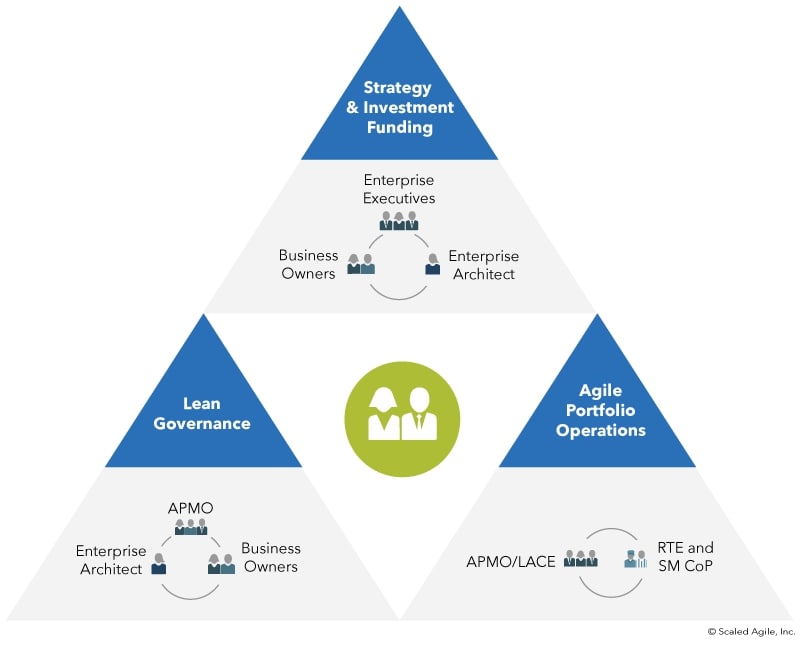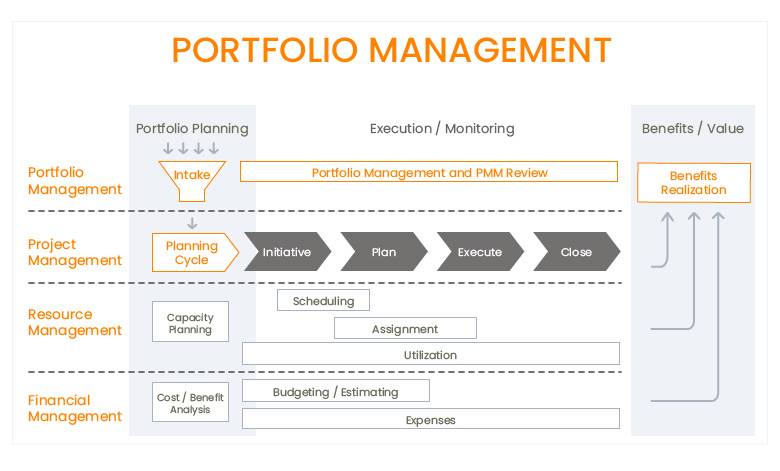For enterprises that strive to deliver maximum value for their customers, the Lean Portfolio Management (LPM) approach helps optimize portfolio management across the organization and mitigate the problems associated with traditional approaches.
This article discusses what LPM is and how to practice it to align your business strategy, improve organizational productivity, and harness the maximum potential of your organization.
What is Lean Portfolio Management?
The Lean Portfolio Management (LPM) is a key element of the Scaled Agile Framework. It focuses on aligning the business strategy with its execution by applying lean principles and lean governance.

Credits: Scale Agile Inc
The LPM teams allocate the budgets and organize and manage teams to execute the business strategy to deliver great customer value all the time. The Lean approach maximizes the speed of the delivery of value, creates the portfolio vision, manages the portfolio budget, and establishes better servant leadership.
Lean Portfolio Management vs Traditional Portfolio Management
Lean Portfolio Management differs from traditional project portfolio management in many ways. While traditional portfolio management focuses on work and deliverables, LPM focuses more on achieving business outcomes.

Credits: Inova Prime
The budget management with the LPM approach happens once every quarter of the year. The teams in the traditional approach are short-lived, and there is less power in decision-making. The LPM also helps organizations make long-standing teams that break silos and empower them to define their work.
What’s more, the traditional portfolio management methods practice the waterfall methods where dependencies exist with prior tasks. LPM practices an agile way of working towards implementing a solution. These characteristics have made LPM the most preferred way of portfolio management for many organizations.
How to Practice Lean Portfolio Management
Adopting lean portfolio management in an organization is not that hard but requires following several best practices. When organizations combine the LPM practices with agile development, it helps improve business agility.
Let’s examine how organizations implement lean portfolio management strategies and make their future more sustainable.
Formulate the Right Leadership
The right leadership is the key driving force behind any successful project or organization. Lean portfolio management is effective if your project has the right leaders to align the business strategy with its execution. If you do not have servant leadership, it takes a long time to adapt to the lean portfolio management strategies. This leadership team must know how to balance finances and empower the development teams to make the decisions on their own.
That said, finding the best leadership with the right skillset is daunting. Hiring managers help you find people with matching skills inside and outside of the organization. An ideal portfolio leadership team helps connect the business goals to deliverables, harnessing your team’s maximum potential. Therefore, to practice the LPM, it is important to formulate the right style of leadership before embarking on its full adaptation.
Manage Funding
Once you have assembled your team with experts, the second thing you must do is get the required funds and manage them. One of the objectives of Lean Portfolio management is managing the funding for executing the business strategy. The LPT shifts the traditional funding from project to teams-based funding. This requires a proper understanding between the business goals and the budget allocation for resources.
First, you need to identify the people who provide the funding and their expectations. Then, identify and prioritize the high-priority projects that cost a lot in order to help you allocate the resources with more confidence. Identifying the existing company resources and how they fit into your budget is best. If budget allocation is difficult with the existing resources, communicate them to the stakeholders as soon as possible to find a better way to allocate the budget without any waste.
Focus on Customer Feedback
By practicing the Lean Portfolio Management Approach, your portfolio leadership team must understand where your project team needs to head. Identify the current and future state of the projects and construct an operating structure that helps you reach the desired state of the portfolio leadership team. The right strategy and investment funding then make it easier to adjust your plan with Agile portfolio operations for changing business requirements.
One of the key aspects of building this operating structure is delivering the best customer value. When practicing LPM, you need to provide the priority to customer satisfaction and create an operating structure to achieve it. One strategy that helps improve customer satisfaction is testing customer feedback.
Customer feedback helps you identify where the gaps lie with your traditional approaches and how to improve them to deliver better customer value. Using customer feedback templates helps you track and organize the feedback faster during the process. Then your team analyzes the results to understand and set customer expectations.
Follow a Lean Workflow
During the Lean Portfolio Management, it is important to organize your work using workflows. Workflows help you refrain from unwanted tasks and improve work efficiency. For example, suppose you did not know your team has completed a certain task. In that case, you wait until you receive the task completion status. To eliminate such work inefficiencies, use portfolio flow management software such as Gantt charts, and Kanban boards to track the progress of your work.
To start with your workflows, gather the required information using techniques like brainstorming, and then draw out a detailed work plan. Then perform work prioritization and resource allocation. Don’t forget to track your progress, monitor the workflow, and get the necessary approvals for your tasks. Lean workflows not only improve employee productivity and performance but also improve creativity.
Encourage Team Contribution
During the Lean Portfolio Management, you must encourage teams to make their own decision by providing the necessary moral support and motivation. Rather than leaders defining their work, teams must engage more in defining their work. This helps them become autonomous teams rather than teams that rely on leadership to make decisions and carry on work based on their decisions.
Celebrate Success
Practicing Lean Portfolio Management is not only about embracing the key concepts and driving your focus towards eliminating traditional approaches. Once you have achieved project milestones with this approach, celebrating that success is a key part. Rewarding your teams whenever you meet the planned business goals and satisfy your customer base is important.
Also, practice identifying the lessons learned if your project didn’t go as planned. Identify the mistakes you made and what you must do to avoid them next time and succeed in your next project. Capture lessons learned in different ways, like through lessons-learned surveys, and retrospective sessions. Be sure to document them so that everyone knows to avoid such mistakes.
Lean Portfolio Management: Key Takeaways
Lean Portfolio Management is a powerful Portfolio Management strategy organizations adopt nowadays for better business outcomes.
This article discusses the ways in which LPM helps mitigate inefficiencies associated with traditional portfolio management.
To practice this portfolio management method, identify the right set of leaders.
Then allocate the budget in an efficient way for your resources. The LPM methods’ primary focus is delivering the best customer value. Therefore, you must always practice a customer-focused mindset.
Last but not least, remember to celebrate your success and incorporate lessons learned from your failed projects to make your next venture successful.